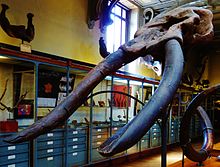Cuvieronius
|
Cuvieronius Temporal range: Pliocene to Holocene, 5.3–0.0091 Ma |
|
|---|---|
 |
|
| Skull of C. hyodon Muséum national d'Histoire naturelle, Paris |
|
| Scientific classification | |
| Kingdom: | Animalia |
| Phylum: | Chordata |
| Clade: | Synapsida |
| Class: | Mammalia |
| Order: | Proboscidea |
| Family: | †Gomphotheriidae |
| Genus: |
†Cuvieronius Osborn, 1923 |
| Type species | |
|
†Mastotherium hyodon Fischer, 1814 (conserved name) |
|
| Species | |
|
|
| Synonyms | |
|
|
Cuvieronius is an extinct New World genus of gomphothere and is named after the French naturalist Georges Cuvier. Alive, species stood, on average, about 2.3 m (7.5 ft) tall at the shoulder, weighed about 3.5 tonnes (3.9 tons) and would have superficially resembled modern elephants with spiral-shaped tusks.
The species now known as Cuvieronius hyodon was among the first fossil animals from the new world to be studied. The first remains of this species were recovered from Ecuador by Alexander von Humboldt, at a location the local population referred to as the "Field of Giants". Humboldt recognized that, rather than being bones of giant humans as had been thought by the local population and previous Spanish colonists, they were similar to the giant elephants (Mastodon) being described from Ohio. Humboldt sent teeth that he had collected from Mexico, Ecuador, and Chile to French anatomist Georges Cuvier, who classified the teeth into two species, which he referred to as the "mastodonte des cordilières" and the "mastodonte humboldien", in an 1806 paper. It was not until 1824 that Cuvier formally named the species. He referred both to the genus Mastodon, calling them M. andium and M. humboldtii.
Unbeknownst to Cuvier, Fischer had, in 1814, already named the two species based on Cuvier's original description, in the new genus Mastotherium as M. hyodon and M. humboldtii. The idea of two distinct species continued to be accepted into the 20th Century, usually using Cuvier's names, though Fischer's names were older. In 1923, Henry Fairfield Osborn recognized that these species were distinct from Mastodon, and assigned each to its own new genus, as Cuvieronius humboldtii and Cordillerion andium. However, by the 1930s, general agreement had shifted to regard both forms as representing a single, geographically widespread species, with Cuvieronius humboldtii considered to be the correct name. During the 1950s, the nomenclature of this species became increasingly tangled, as various scientists regarded the type species of the genus Cuvieronius to be Fischer's first published name Mastotherium hyodon, rather than the originally designated Mastodon humboldtii. This situation went unaddressed until 2009, when Spencer Lucas petitioned the International Commission on Zoological Nomenclature to officially change the type species of Cuvieronius to M. hyodon as had been followed for over 50 years by that time, rather than abandoning the well-known Cuvieronius as a synonym. In 2011, Opinion 2276 of the ICZN ruled to conserve the names.
...
Wikipedia
